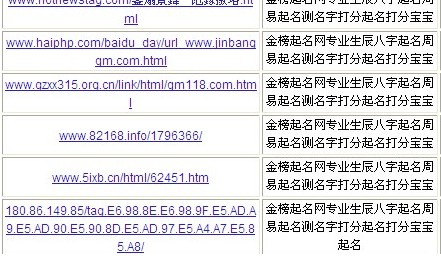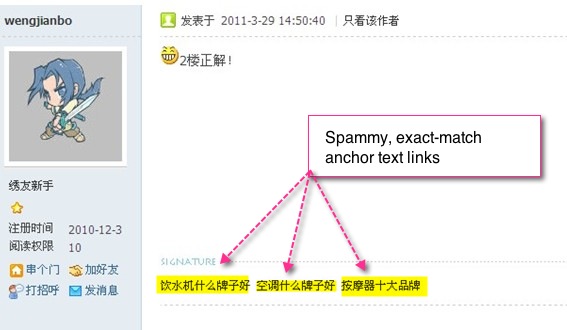How Baidu Determines Link Quality

There’s a lot of talk about backlink quality recently. With the recent rollouts of the Panda and Penguin algorithm updates, Google has increasingly been going after link spammers with a vengeance.
But what about Baidu? While some may say that Baidu is less sophisticated than Google in recognizing linkspam, it would be naive to think that Baidu takes a complacent attitude towards those that try to manipulate search results. In a recent blog post Baidu has come out clearly addressing the issue, explaining what they consider to be manipulative link practices, and how they treat sites that engage in such techniques.
A full English translation of the article is available below, but we’ve summarized the main points:
Baidu clearly states that the only criterion used in determining whether a backlink is questionable is if it represents a true recommendation from the linking website to the target website. Anything else is problematic.
Baidu divides questionable backlinks into 2 categories: garbage backlinks and backlink spam.
Links that do not represent true recommendations from the referring site, but are not created intentionally by the target website in order to manipulate search rankings.
Baidu claims that they can identify 98% of these types of links, but since most of these links were machine-generated and were not intended to manipulate search rankings, they will be filtered out during algorithmic calculations, but not result in any penalty or adverse effects to the target site.
Examples of garbage backlinks:
Links that are created by the target (benefiting) website either manually or programmatically, with the main purpose of deceiving search engines and manipulating search engine rankings.
In addition to detecting and filtering these links, Baidu will also penalize the target website for ownership of such backlink spam.
Examples of backlink spam:
For more details, see the translation below from Baidu’s Webmaster blog (Simplified Chinese):
Determining Backlink Quality
This document is divided into four main content areas:
- How to determine whether or not a backlink is problematic – Real-world examples
- The difference between two kinds of problematic links: Garbage links and linkspam
- A few examples of the most common methods used to create linkspam.
- Detailed explanation of linkspamming behavior
1. How to determine whether or not a backlink is problematic – Real-world examples
Baidu only uses a single criterion to determine whether or not a backlink is problematic: Whether or not the link represents a true, honest, and intentional recommendation from the linking website to the target website.
2. The difference between two kinds of problematic links: Garbage links and linkspam
2.1. Garbage links
Linking to a website without the intention to recommend the site: The website owners did not intentionally build the link. This includes but is not limited to: Links on search result pages, links on automatically generated pages on webmaster service sites, links automatically generated through scraping, etc. Baidu is already able to recognize and filter out 98% of these types of links, and these links will not have direct negative consequences for the site.
2.2 Manipulative Linkspam
Using people or machines to build links meant to deliberately trick search engines, with the intent to manipulate search engine rankings to benefit the website owner. Including but not limited to: Anchor text manipulation, buying link authority, hacked links, large quantity, low-quality backlinks, link wheels, etc. These types of links will be filtered out of search results. At the same time, the receiver of these types of links will certainly have action taken against them resulting in direct negative consequences.
2.3 Garage link description:
2.3.1 Links produced through search results. There’s no need to list examples, as the internet is full of these kinds of links. Baidu already filters out these kind of links and they are not given any significant weight in our algorithm calculations.

2.3.2 Webmaster service sites that automatically create links. For example, www.myip.cn/exlink/dw20.com (If you’re having trouble accessing the page, please try http://cang.baidu.com/cases99/snap/48f469a28c15971cfd07d5a1.html). The links listed under “15 site backlink” are all this kind of garbage backlinks.
2.3.3 Links automatically generated through scraping. For example:

2.4. Linkspam Description
Linkspam comes in many different forms, and as time goes on new and different tactics will continue to emerge. However, techniques such as anchor text manipulation, backlinks created with the sole purpose of increasing authority, bulk acquisition of backlinks, and other similar techniques never change.
3. A few examples of what Baidu sees as the most common methods used in creating manipulative linkspam includes but is not limited to:
3.1 Anchor text manipulation: Using artificial anchor text, etc.
3.2 Backlinks created with the sole purpose of increasing authority: Using black-hat methods to inject links into a site, buying or selling links, link farms, link wheels, etc.
3.3 Bulk acquisition of backlinks: Web 2.0 (Obviously spammy ones include forum (BBS) signatures, linking your username in comment threads, fake reviews or advertisements, etc.), reciprocal linking, link farms, etc.
3.4 Cloaking: Showing the Baidu spider and site users different content.
4. Detailed explanation of linkspamming behavior
4.1 Anchor text manipulation – Detailed explanation:
Large batches of links with artificially created anchor text. For example: Using other well-known website or business as your own anchor text. For example, many Taobao shops or other well-known ecommerce sites using “Taobao” or other well-known brand names for their anchor text in links to their own sites.
4.2 Backlinks created with the sole purpose of increasing authority – Detailed Explanation:
4.2.1 Black-hat injected links:
Exploiting a site’s loopholes, hackers may artificially inject links into a site. In order to not attract users or webmasters’ attention, most of the time these links will be invisible to site visitors. However, they’re easily found by looking at the source code or the site’s logs at the destination URL of outbound links.
Example 1: http://www.ngzc.com/

Example 2: (already taken down, see image)

Explanation: Hackers have taken advantage of a loophole on 上海 亚货运代理有限公司’s page on www.huiya56.com (specifically) to inject links to their own site. The site owners down’t know about this link, and the links has absolutely nothing to do with the content on 上海 亚货运代理有限公司’s page.
At the very bottom of the page, you can see many links point to the hacker’s site. For example, the text “存话费 手机电信”. “河北唐山移动营业厅”. These are all examples of injected links.
4.2.2 Buying and selling links
Once these types of links were commonly known as “Golden links”, “Platinum links” and “Wealth links”. Of course, nowadays buying and selling links is a much more secretive process. Most will never directly label links as “Golden links”.
Below is a detailed explanation:
Golden links:

Wealth links:

4.2.3 Link farms
A large number of related sites (the same person creates x number of sites, or one SEO company creates more than one site), often times using a large number of exact match anchor text to make reciprocal links to each other, for the purpose of increasing a site’s ranking. For example:

4.3 Large-scale, low quality backlinks – Detailed Explanation:
4.3.1 Web 2.0
4.3.1.1 Obviously manipulative: Inserting links with keywords into BBS forums or blog posts, such as yellow pages or B2B portal sites.
For example:
(If having trouble accessing the page, please use http://cang.baidu.com/cases99/snap/49b3b2757f546305056c14f2.html)
and
http://china.nowec.com/product/detail/854635.html (If having trouble accessing the page, please use http://cang.baidu.com/cases99/snap/49ae7710f43e9b0c745358f2.html)
Explanation: Both links are one company posting links back to their site on two different yellow pages sites. In the fine print at the bottom of the page you can see anchor text of a link back to their site “北京藤制家具厂北京藤椅北京藤器北京藤家具北京藤工艺藤家具藤椅藤椅价 藤椅销售供应藤椅 供应藤家具藤椅优 价 环保藤椅藤椅图片藤椅厂卖藤椅藤制家具厂藤椅藤制品藤家具藤工艺品藤艺北京藤制家具厂藤椅藤制品藤家具藤工艺品藤艺”, a classic example of typical methods used.
4.3.1.2 BBS or Forum Signatures:
Making numerous and repeated forum posts with links in the personal signature, often using exact-match anchor text.
Example: http://www.7szx.com/thread-176713-1-1.html(If you have trouble viewing the page, try http://cang.baidu.com/cases99/snap/0248af1419a770f3118d1886.html )
Explanation: The signature in this forum reply contains the text: “What’s a good brand for water coolers?” “What’s a good brand for air conditioners?” “The 10 best massage machines”, all of which link back to www.manmanbuy.com, another typical example of anchor text manipulation.

4.3.1.3 Anchor text fraud:
Linking to your website using fraudulent anchor text, such as claiming the page is something it is not.
Example: http://blog.alipay.com/716.html (if you’re having trouble accessing the page, try http://cang.baidu.com/cases99/snap/e6a665e2951b782d2109e6f5.html)

Explanation: The 93rd commenter is named “taobao”, which creates a link with this as its anchor text, but does not link to the Taobao site.
4.3.1.4 Fake reviews which are really advertisements:
In many BBS, forum, or other Web 2.0 type sites, you can usually add links to a post. These kinds of posts have absolutely no connection to the thread topic, and were simply created through machine automation to post articles with links back to the site.
Example: (if you’re having trouble accessing the page, try http://cang.baidu.com/cases99/snap/eb07350b5acdde633c0e49a8.html )
Explanation: There’s no problem with the post itself. The problem is that often times a server will automatically post a large volume of near-identical posts with links similar to this one in an attempt to artificially inflate the target page’s authority.
4.3.1.5 Other techniques:
The techniques we’ve listed above are by no means an exhaustive list. However, we believe humans can normally spot the vast majority of them without difficulty.
For example: http://club.alimama.com/read-htm-tid-2136044.html (if you’re having trouble accessing the page, try http://cang.baidu.com/cases99/snap/336396789cd4f723774aceaf.html)

Explanation: The placement of the link in the text is obviously unnatural. This link is clearly not intended for the readers of the article, but instead for the sole purposes of deceiving search engines in order to artificially manipulate their page authority.
4.3.2 Link networks
Creating a large number of independent sites, concentrating all of their link juice towards one or a small number of URLs, or creating link wheels.
4.4 Cloaking
Some unscrupulous sites will serve the Baidu spider and other site users different versions of the same page (the content is completely different), or will redirect Baidu spiders to a different page. Strictly speaking, this kind of manipulation is not classified as linkspam, but is still a type of manipulative behavior. Sites that practice cloaking will undoubtably be dealt with very severely by Baidu.
In general, these guidelines shouldn’t be to the surprise of any SEOs. They’re much on par with Google’s linking guidelines, and should be common sense to any white-hat practitioners. Still, the guidelines represent a trend in Baidu’s increasing willingness to engage with the webmaster community and provide more insight and transparency into its updates. It’s a welcomed step in the right direction, and we’re hoping that Baidu is able to continue to increase its detection of linkspam.